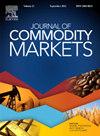Twin commodity shocks: A multi-to-one CoVaR analysis of systemic risk spillovers from gold and crude oil to emerging market currencies
IF 4.5
4区 经济学
Q1 BUSINESS, FINANCE
引用次数: 0
Abstract
This study examines the systemic risk spillovers from gold and crude oil to six major emerging market currencies, with particular attention to the role of U.S. dollar (USD) strength in shaping these risk transmission mechanisms. We develop a multi-to-one Conditional Value-at-Risk (MCoVaR) analysis framework, extending the traditional CoVaR methodology by using time-varying canonical vine copulas to capture the dependence structures among gold, oil, and emerging market currencies. Our findings first reveal positive pairwise dependencies between gold, crude oil, and each currency, with heterogeneous dependence structures in how individual currencies relate to the two commodities. Crucially, the MCoVaR estimates confirm that emerging market currencies experience amplified risk spillovers during joint extreme shocks in gold and oil markets. Moreover, USD strength variation plays a crucial role in shaping commodity-to-currency systemic risk transmission by not only directly influencing the valuations of gold, oil, and emerging market currencies but also indirectly affecting the time-varying dependence between these assets. These findings highlight the importance of systemically accounting for joint commodity shocks in currency risk assessment, especially during periods of sustained USD strength with volatile commodity prices.
双重大宗商品冲击:黄金和原油对新兴市场货币系统性风险溢出的多对一CoVaR分析
本研究考察了黄金和原油对六种主要新兴市场货币的系统性风险溢出效应,并特别关注美元(USD)强势在塑造这些风险传导机制中的作用。我们开发了一个多对一的条件风险价值(MCoVaR)分析框架,扩展了传统的CoVaR方法,使用时变正则藤copulas来捕捉黄金、石油和新兴市场货币之间的依赖结构。我们的研究结果首先揭示了黄金、原油和每种货币之间的正成对依赖关系,以及每种货币与这两种商品之间的异质性依赖结构。至关重要的是,MCoVaR的估计证实,在黄金和石油市场的联合极端冲击期间,新兴市场货币的风险溢出效应被放大。此外,美元的强弱变化不仅直接影响黄金、石油和新兴市场货币的估值,还间接影响这些资产之间的时变依赖关系,在塑造商品到货币的系统性风险传导中起着至关重要的作用。这些发现强调了在货币风险评估中系统地考虑大宗商品冲击的重要性,特别是在美元持续走强而大宗商品价格波动的时期。
本文章由计算机程序翻译,如有差异,请以英文原文为准。
求助全文
约1分钟内获得全文
求助全文
来源期刊

Journal of Commodity Markets
Multiple-
CiteScore
5.70
自引率
2.40%
发文量
53
期刊介绍:
The purpose of the journal is also to stimulate international dialog among academics, industry participants, traders, investors, and policymakers with mutual interests in commodity markets. The mandate for the journal is to present ongoing work within commodity economics and finance. Topics can be related to financialization of commodity markets; pricing, hedging, and risk analysis of commodity derivatives; risk premia in commodity markets; real option analysis for commodity project investment and production; portfolio allocation including commodities; forecasting in commodity markets; corporate finance for commodity-exposed corporations; econometric/statistical analysis of commodity markets; organization of commodity markets; regulation of commodity markets; local and global commodity trading; and commodity supply chains. Commodity markets in this context are energy markets (including renewables), metal markets, mineral markets, agricultural markets, livestock and fish markets, markets for weather derivatives, emission markets, shipping markets, water, and related markets. This interdisciplinary and trans-disciplinary journal will cover all commodity markets and is thus relevant for a broad audience. Commodity markets are not only of academic interest but also highly relevant for many practitioners, including asset managers, industrial managers, investment bankers, risk managers, and also policymakers in governments, central banks, and supranational institutions.
 求助内容:
求助内容: 应助结果提醒方式:
应助结果提醒方式:


